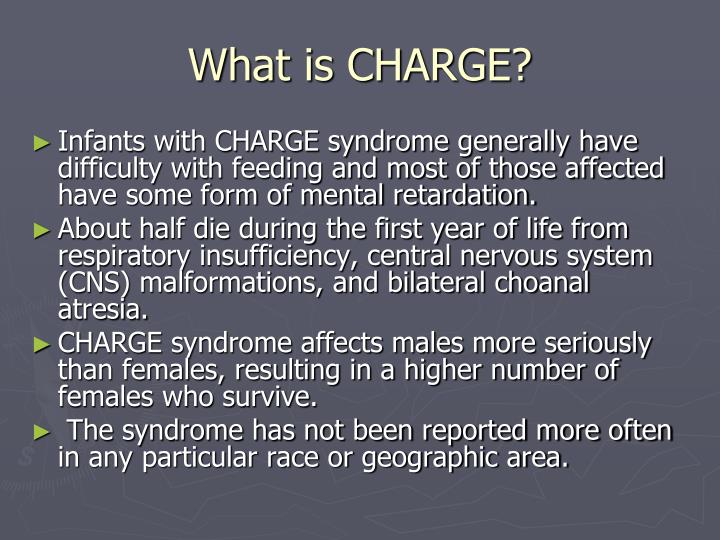
There are conditions believed to be related to prenatal alcohol exposure, such as spontaneous abortion and sudden infant death syndrome (SIDS), which are also considered to be on the spectrum of related disorders.
#Charge syndrome life span full
Partial fetal alcohol syndrome (pFAS) refers to individuals with a known, or highly suspected, history of prenatal alcohol exposure who have alcohol-related physical and neurodevelopmental deficits that do not meet the full criteria for FAS.Īs of 2016, the Swedish Agency for Health Technology Assessment and Assessment of Social Services accepted only FAS as a diagnosis, seeing the evidence as inconclusive with respect to other types. The most severe condition is called fetal alcohol syndrome (FAS), which refers to individuals who have a specific set of birth defects and neurodevelopmental disorders characteristic of the diagnosis. įetal alcohol spectrum disorders encompass a range of physical and neurodevelopmental problems which can result from prenatal alcohol exposure. The term fetal alcohol syndrome was first used in 1973. However, a 2015 review article estimated the overall costs to Canada from FASD at $9.7 billion (including from crime, healthcare, education, etc.). The lifetime cost per child with FAS in the United States was estimated at $2 million (for an overall cost across the country of over $4 billion) by the CDC in 2002. The negative effects of alcohol during pregnancy have been described since ancient times. In South Africa, some populations have rates as high as 9%. FAS is believed to occur in between 0.2 and 9 per 1,000 live births in the United States. įASD is estimated to affect between 1% and 5% of people in the United States and Western Europe. Interventions may include parent–child interaction therapy, efforts to modify child behavior, and drugs. Although the condition is permanent, treatment can improve outcomes. For this reason, medical authorities recommend that women completely avoid drinking alcohol during pregnancy and while trying to conceive. įetal alcohol spectrum disorders are preventable by the mother's avoiding alcohol during pregnancy. Diagnosis is based on the signs and symptoms in the person. Alcohol crosses the blood–brain barrier and both directly and indirectly affects a developing fetus. Although drinking small amounts does not cause facial abnormalities, it may cause behavioral problems. There is no known safe amount or time to drink alcohol during pregnancy. Other risk factors include the mother's older age, smoking, and poor diet. The risk of FASD depends on the amount consumed, the frequency of consumption, and the points in pregnancy at which the alcohol is consumed.

3.6% of pregnant American women met criteria for an alcohol use disorder in a 2001 epidemiological study. Surveys from the United States found that about 10% of pregnant women drank alcohol in the past month, and 20% to 30% drank at some point during the pregnancy. įetal alcohol spectrum disorders are caused by the mother's drinking alcohol while pregnant with the affected person. As of 2016, the Swedish Agency for Health Technology Assessment and Assessment of Social Services accepted only FAS as a diagnosis, seeing the evidence as inconclusive with respect to other types. The several forms of the condition (in order of most severe to least severe) are: fetal alcohol syndrome (FAS), partial fetal alcohol syndrome (pFAS), alcohol-related birth defects (ARBD), static encephalopathy, alcohol-related neurodevelopmental disorder (ARND) and neurobehavioral disorder associated with prenatal alcohol exposure (ND-PAE). Those affected are more likely to have trouble with school, the legal system, alcohol, other drugs, and other areas of high risk. Symptoms can include an abnormal appearance, short height, low body weight, small head size, poor coordination, behavioral problems, learning difficulties, and problems with hearing and sight. īetween 1 in 20 (~390 million) and 1 in 13 (~600 million) įetal alcohol spectrum disorders ( FASDs) are a group of conditions that can occur in a person who is exposed to alcohol as a result of their mother drinking during pregnancy. Varies depending on the individual, the level of alcohol exposure, and quality of living and educational arrangements. Parent-child interaction therapy, efforts to modify child behavior, possibly medications Fetal alcohol syndrome, partial fetal alcohol syndrome, alcohol-related neurodevelopmental disorder, static encephalopathy, alcohol-related birth defects ĪDHD, autism, bipolar disorder, conduct disorder, learning disability, oppositional defiant disorderĪvoiding drinking alcohol during pregnancy


 0 kommentar(er)
0 kommentar(er)
